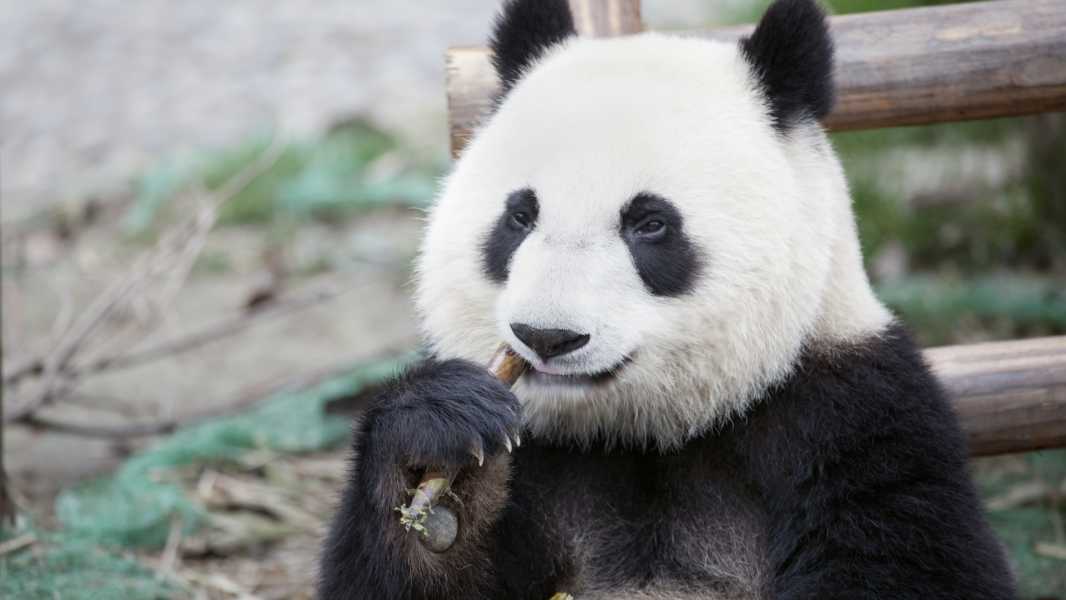
Pandas eat bamboo all day, but do they ever try anything else? (Photo: KingWu via Getty Images)
With its black and white fur, lazy lifestyle, and friendly nature, bamboo is a key element for the endangered giant panda (Ailuropoda melanoleuca). A single individual can consume 26 to 84 pounds (12 to 38 kilograms) of the vegetation daily, spending up to 16 hours munching on the fibrous, chewy plant piece by piece.
These eating habits are so intense that Feng Li, a scientist at China West Normal University, calls the panda a “mobile bamboo chopper.” But do pandas ever diversify their diet beyond the fast-growing plant?
The answer is usually no — though there are rare exceptions. “There have been cases of wild giant pandas occasionally eating small animals,” Li told Live Science in an email. He cited rare cases reported in the Qinling Mountains region of China, where giant pandas have been observed gnawing on the bones of takin (Budorcas taxicolor), a wild, goat-like ungulate. They have also occasionally been found hunting Chinese bamboo rats (Rhizomys sinensis).
John Speakman, head of zoology at the University of Aberdeen in the UK, confirms that these cases are rare and unusual: “There is a picture online of [a panda] at a zoo catching and eating a peacock. However, as far as I know, these are really isolated events.”
Except for these rare instances of carnivory, pandas feed exclusively on bamboo. However, there is an interesting aspect, as there is a lot of evidence that pandas actually need a much more varied diet. In fact, they are not very well adapted to eating bamboo.
Research has shown that bears have a gut structure similar to that of carnivores, like their relatives, and their stomachs lack the multi-chambered structure that other herbivores use to process large amounts of vegetation. Moreover, the microbes that inhabit their gut flora are more like those of meat eaters, and are able to process and extract protein. These microbes are not suited to breaking down plant fibers. Panda feces also support this: the researchers conducting the study found bits of undigested bamboo in them.
The evolutionary history of the panda
These unsuitable traits appear to be an evolutionary legacy of the giant panda's ancestors. Clues from the fossil record show that the ancestors of modern giant pandas ate vegetation as well as meat. Then, about 7 million years ago, fossil evidence suggests that one of the ancestors, known as Ailurarctos, began sampling some bamboo.
According to Li, this was the “beginning of the transition from omnivory to herbivory,” which may have been accelerated by changes in food availability. “There is now an idea that environmental changes in ancient times led to a significant reduction in food resources. The ancestors of giant pandas were in intense competition with other carnivores,” Li said.
The researchers believe that by adding bamboo to its diet, Ailurarctos gained an adaptive advantage and was able to survive in conditions of scarcity by occupying this ecological niche. “The evolutionary process that led to the giant pandas’ transition from an omnivorous diet to an exclusively bamboo diet is a classic example of ‘survival of the fittest, but not necessarily the best’ in evolutionary biology,” Li added.
However, while their evolutionary background may seem ill-suited to a bamboo-rich diet, giant pandas have also developed several adaptations that suit their conditions. For example, the gene that allows them to taste the unique umami flavor of meat has been deactivated in their DNA, indicating that they likely do not have a natural attraction to fresh meat, Li said. Pandas also have very slow metabolisms, which helps them survive on a low-calorie bamboo diet. In fact, pandas expend only 38 percent of their daily energy
Sourse: www.livescience.com





